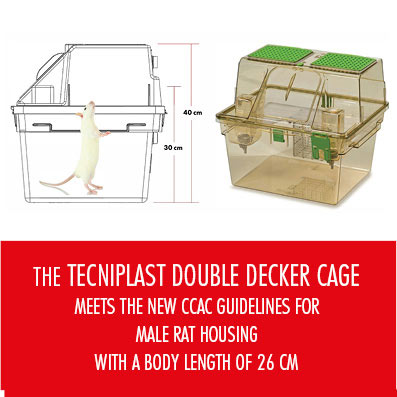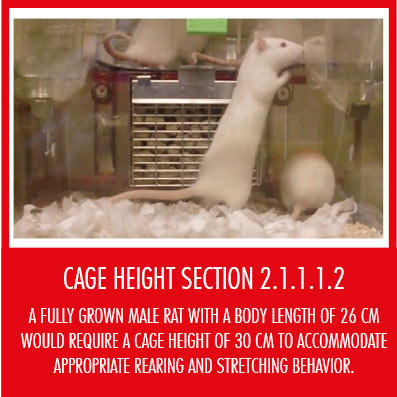
The current version of the Tecniplast website doesn't match your region. Please visit your local website to find information and offerings specific to your country.

The current version of the Tecniplast website doesn't match your region. Please visit your local website to find information and offerings specific to your country.

 The Tecniplast Double Decker Cage meets the new CCAC guidelines for male rat housing with a body length of 26 cm.
The Tecniplast Double Decker Cage meets the new CCAC guidelines for male rat housing with a body length of 26 cm.
Gilly Griffin, Director of Standards and Sylvie Cloutier, Associate Director of Assessment of Canadian Council on Animal Care (CCAC), share with us their experience in the evaluation of animal welfare in Canada.
The CCAC works to ensure that animal-based science in Canada takes place only when necessary and that the animals in the studies receive optimal care according to high quality, research-informed standards. Panorama shows how Tecniplast’s products meet the new CCAC guidelines.
CAGE HEIGHT SECTION 2.1.1.1.2 A fully grown male rat with a body length of 26 cm would require a cage height of 30 cm to accommodate appropriate rearing and stretching behavior.
In the new CCAC guidelines, Multilevel cages are mentioned as having welfare benefits. Can you list what the welfare benefits have been in your experience and understanding of this type of caging system?
The CCAC guidelines: Rats (2020) introduced the concept of multilevel cages to improve the quality of life for rats held in animal facilities. In their natural habitat, rats exhibit complex behaviours such as digging, burrowing, running, jumping, climbing, and stretching upright, among others, which have not been extinguished, despite hundreds of generations in captivity. This was beautifully demonstrated in Berdoy’s (2002) video “A rats life”.
For rats that are breeding, having multi levels provides the mother with the opportunity to remove herself from the pups (e.g., Cloutier and Newberry,2013) much like she would be doing in the wild.
For animals undergoing experimental procedures multilevel cages have been shown to reduce anxiety (e.g., Vachon, 2014). Hence, providing laboratory rats with a complex, three-dimensional environment gives them opportunities to engage in as many of these behaviors as possible.
Such an environment is not only beneficial for the rats, keeping them physically and psychologically healthy (Wheeler et al., 2015; Dodelet-DeVillers et al.,2016), but it also means that research data is more robust.
 With the concept of larger space for the animals there was an emphasis on furnishings to enhance welfare. When providing more space, why is it so critical to also have this space enriched? If using a Double Decker unit how is this space inherently enriched by adding a second level?
With the concept of larger space for the animals there was an emphasis on furnishings to enhance welfare. When providing more space, why is it so critical to also have this space enriched? If using a Double Decker unit how is this space inherently enriched by adding a second level?
It is important to clearly distinguish between meeting the basic needs of animals, versus providing enrichment opportunities. Each of the CCAC animal-type guidelines requires institutions to meet animals’ basic needs, and encourages the implementation of enrichment strategies.
The CCAC guidelines: Rats, states that the basic needs include group housing, shelters, and sufficient space to accommodate these elements and the expression of behaviors important to rat welfare. Enrichment opportunities include features to promote activity, substrates for burrowing, structures to facilitate hiding or avoidance, objects to chew, variety in food, and foraging opportunities. The CCAC guidelines: Rats promotes a performance-based approach to allocating cage space. Institutions are encouraged to evaluate the cage space based on the requirements of the animals, e.g., the size as well as the age of the rats, and the types of studies. Minimally, this requires provision of sufficient area for exercise and normal social behavior as well as the inclusion of enrichment items. In addition, research has also shown that rats have shown preference for cages with increased complexity (Anzaldo et al., 1994). Thus, a complex environment providing enough space to express species-specific behaviors will be the most beneficial.
Floor area was addressed to assure this was adequate for normal behaviors (defined as social interactions (both affiliative and agonistic) interactions, foraging, walking, running, jumping, fully stretching laterally, and play (for young rats). With multilevel cages are there benefits in promotion of the normal behaviors?
 Multilevel cages do offer the opportunity for rats to use the space to engage in important behaviors. Rats are highly social and engage in different types of social interactions. For young rats in particular, multilevel cages offer the opportunity for play and chasing, as well as climbing. For older animals, the multilevel cages permit segregation of activities, facilitate vertical stretching and climbing, and permit the animals to escape from negative interactions more easily.
Multilevel cages do offer the opportunity for rats to use the space to engage in important behaviors. Rats are highly social and engage in different types of social interactions. For young rats in particular, multilevel cages offer the opportunity for play and chasing, as well as climbing. For older animals, the multilevel cages permit segregation of activities, facilitate vertical stretching and climbing, and permit the animals to escape from negative interactions more easily.
The height of rat cages has been controversial for many years. The earlier height allowances did not allow the need of the vertical stretching in rats as a normal behavioral component. Now that this behavior is more commonly known and recognized this is addressed in the updated document. In your opinion was this a lesser issue in the multilevel cages and were you able to see this normal behavior in these cages more readily?
Makowska and Weary (2016) highlighted the importance of vertical stretching. Their studies showed that in cages where vertical stretching was limited, rats engaged in more lateral stretching behaviors. This highlights the importance of stretching, and the need to provide sufficient space to be able to do so, preferably vertical space. Studies assessing rat behaviors in multilevel cages have reported increased activities but, nothing specifically about vertical stretching (Wheeler et al., 2015). Thus, more work is needed in this area. However, anecdotally, there should be sufficient vertical space in areas of the multilevel cage to facilitate the expression of this behavior.
With the primary emphasis on research rat welfare housing, and based on the general research areas including breeding components, are there true advantages in outcomes with the use of multilevel cage designs?
CCAC guidelines are based on the best scientific evidence available at the time of developing the document, as well as expert opinion. Scientific evidence is always evolving, so a guidelines document crystalizes what is known at the time of publication (or more accurately a year prior to publication). There is not a large body of information on the impact of housing on research results as the comparative studies are few. What we do know are some of the key factors that can improve rat welfare, and that where animal welfare is improved (even if it introduces variability), there is a positive impact on research outcomes (Richter, 2017). As mentioned earlier, an environment that is complex (i.e., with structures, objects and substrate) and provides enough space to express specie-specific behaviors will be the most beneficial for rats.
MASSIMO FERRARI - MARKETING MANAGER - TECNIPLAST NORTH AMERICA